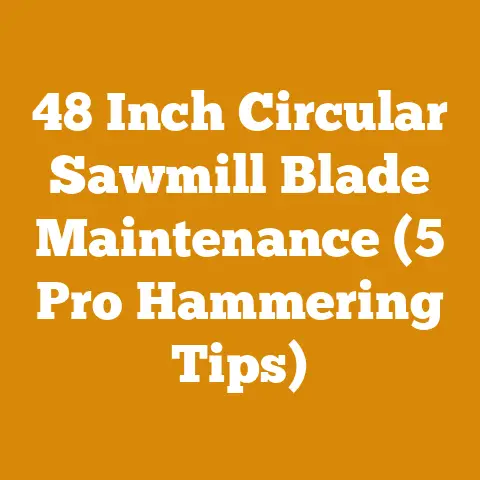How Far to Put Wood Stove from Wall (Expert Clearance Tips)
I’ll never forget the day I almost burned down my shed. It was a crisp November evening, and I had just installed a small wood stove in my workshop. Excited to have a warm place to tinker through the winter, I loaded it up with seasoned oak and fired it up. The crackling flames and radiating heat were exactly what I had envisioned. What I hadn’t envisioned was the smell of burning wood… coming from the WALL.
In my eagerness, I had completely underestimated the importance of proper clearances. The stove was way too close to the combustible wall, and the heat was beginning to char the wood studs. A frantic call to the fire department and a lot of thrown water later, disaster was averted. That day, I learned a valuable lesson: installing a wood stove is not just about connecting the flue and lighting a fire. It’s about understanding the science of heat transfer and following strict safety guidelines.
If you’re considering heating your home or workshop with a wood stove, you’re in the right place. I’m going to share everything I’ve learned about wood stove clearances – the hard way – so you can avoid making the same mistakes I did.
Key Takeaways:
- Clearances are Critical: Understanding and adhering to wood stove clearance requirements is paramount for fire safety.
- Manufacturer’s Instructions are Law: Always prioritize the stove manufacturer’s specifications over general guidelines.
- Wall Protection Matters: Different types of wall protection systems offer varying levels of heat reduction.
- Professional Installation is Recommended: When in doubt, consult a qualified professional for safe and compliant installation.
- Regular Inspections are Essential: Regularly inspect your wood stove and chimney system for proper function and safety.
Understanding Wood Stove Clearances: A Deep Dive
The primary reason for maintaining proper clearances around a wood stove is to prevent combustible materials from reaching their ignition temperature. Wood, drywall, furniture, and even some types of flooring can ignite if exposed to prolonged high heat. Wood stoves radiate heat in all directions, and without adequate clearance or proper shielding, this heat can easily start a fire.
Why are clearances so important?
- Preventing Fire Hazards: This is the most obvious and crucial reason. A fire originating from a poorly installed wood stove can quickly spread and cause significant damage, injury, or even death.
- Protecting Your Investment: A fire can destroy your home or workshop, leading to significant financial losses. Proper clearances help protect your property and belongings.
- Ensuring Insurance Coverage: Many insurance companies require wood stoves to be installed according to local codes and manufacturer’s instructions. Failure to comply can void your insurance policy.
- Maintaining Air Quality: Improperly installed wood stoves can lead to inefficient combustion and increased emissions. Proper clearances help ensure the stove operates efficiently and minimizes air pollution.
Decoding the Clearance Requirements: Manufacturer’s Specs vs. General Guidelines
The first and most important rule of wood stove installation is to always consult the manufacturer’s instructions. These instructions are specific to your particular stove model and will outline the minimum clearances required for safe operation.
Why Manufacturer’s Specs Take Precedence:
- Specific Testing: Manufacturers conduct rigorous testing to determine the heat output and radiation patterns of their stoves. The clearance requirements are based on these tests.
- Model Variations: Even stoves that look similar can have different heat characteristics. The manufacturer’s instructions account for these variations.
- Warranty Compliance: Installing a stove outside of the manufacturer’s specifications can void the warranty.
However, manufacturer’s instructions aren’t always crystal clear, and sometimes, general guidelines are needed to supplement them. Here’s a breakdown of how to interpret both:
1. Manufacturer’s Instructions:
- Locate the Manual: The manual should be included with your stove. If you can’t find it, check the manufacturer’s website.
- Identify Clearance Requirements: Look for a section specifically dedicated to installation clearances. It will typically include diagrams and measurements.
- Understand “Clearance to Combustibles”: This is the minimum distance required between the stove and any combustible material.
- Note Any Exceptions: Some manufacturers allow for reduced clearances with specific wall protection systems.
2. General Guidelines (Based on NFPA 211):
The National Fire Protection Association (NFPA) Standard 211 provides general guidelines for chimney, fireplace, and venting systems. While not legally binding, it’s widely considered a best practice and is often referenced by local building codes.
- Unprotected Walls: If you’re installing a stove near an unprotected combustible wall, the NFPA 211 recommends a minimum clearance of 36 inches from the stove body to the wall.
- Protected Walls: With proper wall protection, you can significantly reduce these clearances. We’ll delve into wall protection systems in detail later.
- Corner Clearances: If the stove is installed in a corner, the clearances may need to be even greater, depending on the angle of the walls.
- Floor Protection: In addition to wall clearances, you’ll also need to provide adequate floor protection beneath and around the stove. This is typically achieved with a non-combustible hearth pad. The size and thickness of the hearth pad will depend on the stove’s size and design.
Example:
Let’s say you’re installing a small cast iron wood stove. The manufacturer’s instructions state a minimum clearance of 24 inches to combustible walls. However, your local building code requires compliance with NFPA 211, which recommends 36 inches for unprotected walls. In this case, you would need to either increase the clearance to 36 inches or install a wall protection system that meets the requirements of both the manufacturer and NFPA 211.
My First Lesson: The Importance of Proper Floor Protection
Before my near-disaster with the wall, I almost scorched my floor! I had placed the wood stove on what I thought was a sufficient piece of cement board. Wrong. It wasn’t thick enough, and it didn’t extend far enough beyond the stove. Embers would occasionally pop out when I opened the door to reload, and they landed directly on the unprotected wood floor.
Floor Protection Requirements:
- Non-Combustible Material: The hearth pad must be made of a non-combustible material like cement board, brick, stone, or metal.
- Thickness: The required thickness depends on the stove’s bottom temperature. The manufacturer’s instructions will specify the minimum R-value (resistance to heat flow) of the hearth pad.
- Size: The hearth pad must extend a certain distance beyond the stove in all directions. This distance is typically specified in the manufacturer’s instructions and may vary depending on the stove’s design. A common rule of thumb is to extend the hearth pad at least 16 inches in front of the stove door and 8 inches on the sides and back.
My Solution:
I ended up replacing the thin cement board with a properly sized and thicker hearth pad made of slate tiles set in mortar on a cement board base. It not only provided adequate protection but also added a touch of rustic charm to my workshop.
Reducing Clearances: The Magic of Wall Protection Systems
One of the biggest challenges of installing a wood stove is often the limited space available. Meeting the minimum clearance requirements can be difficult, especially in smaller rooms. Fortunately, there are several wall protection systems that can significantly reduce the required clearances.
How Wall Protection Works:
Wall protection systems work by creating an air gap between the stove and the combustible wall. This air gap acts as an insulator, reducing the amount of heat that reaches the wall.
Types of Wall Protection Systems:
- Spacers and Non-Combustible Sheeting: This is one of the most common and cost-effective methods. It involves attaching non-combustible sheeting (such as cement board or metal) to the wall using non-combustible spacers. The spacers create an air gap between the sheeting and the wall.
- Masonry Walls: A masonry wall (brick or stone) can provide excellent protection, but it must be properly constructed and have an air gap behind it.
- UL-Listed Wall Shields: These are commercially available wall shields that have been tested and listed by Underwriters Laboratories (UL). They are designed to provide a specific level of heat reduction.
Calculating Clearance Reductions:
The amount of clearance reduction you can achieve with a wall protection system depends on several factors, including:
- Type of Wall Protection: Different systems offer different levels of heat reduction.
- Air Gap: The wider the air gap, the greater the heat reduction.
- Ventilation: Adequate ventilation behind the wall protection is essential to ensure proper airflow and heat dissipation.
NFPA 211 provides guidelines for clearance reductions based on the type of wall protection:
- Solid Masonry Wall (at least 4 inches thick): Can reduce clearances by up to 66%.
- Non-Combustible Sheeting with 1-inch Air Gap: Can reduce clearances by up to 50%.
- UL-Listed Wall Shield: The clearance reduction will be specified by the manufacturer of the shield.
Example:
Let’s say your stove requires a 36-inch clearance to an unprotected wall. You install a non-combustible sheeting with a 1-inch air gap. According to NFPA 211, this can reduce the clearance by up to 50%. Therefore, the new required clearance would be 18 inches (36 inches x 0.5 = 18 inches).
Building Your Own Wall Protection System:
While you can purchase commercially available wall shields, it’s also possible to build your own. Here’s a step-by-step guide:
- Gather Materials: You’ll need non-combustible sheeting (cement board or metal), non-combustible spacers (metal washers or ceramic tiles), screws, and framing materials (if needed).
- Frame the Wall (Optional): If your wall is uneven or you want to create a larger air gap, you can build a simple frame using non-combustible materials.
- Attach Spacers: Securely attach the spacers to the wall using screws.
- Attach Sheeting: Attach the non-combustible sheeting to the spacers using screws.
- Ensure Ventilation: Make sure there is adequate ventilation at the top and bottom of the wall protection system to allow for airflow.
Important Considerations:
- Local Codes: Always check with your local building inspector to ensure your wall protection system meets local code requirements.
- Proper Installation: Improper installation can render the wall protection system ineffective. Follow the manufacturer’s instructions carefully.
- Regular Inspection: Regularly inspect the wall protection system for damage or deterioration.
Chimney Clearances: The Often-Overlooked Danger Zone
While wall clearances are crucial, chimney clearances are equally important. The chimney is responsible for venting hot gases and smoke away from the stove, and it can get extremely hot during operation.
Chimney Clearance Requirements:
- Manufacturer’s Instructions: Again, the manufacturer’s instructions are the primary source of information for chimney clearances.
- Type of Chimney: The type of chimney (metal or masonry) will affect the clearance requirements.
- NFPA 211: NFPA 211 provides guidelines for chimney clearances, particularly for masonry chimneys.
Common Chimney Clearance Issues:
- Combustible Framing: Chimneys often pass through walls and ceilings. It’s crucial to maintain adequate clearance between the chimney and any combustible framing materials.
- Attic Insulation: Attic insulation can easily come into contact with a hot chimney, creating a fire hazard.
- Roof Overhangs: Chimneys should be located away from roof overhangs to prevent the accumulation of creosote and the risk of a chimney fire.
Maintaining Proper Chimney Clearances:
- Use a Chimney Thimble: A chimney thimble is a metal sleeve that provides a safe passage for the chimney through a wall or ceiling.
- Install a Chimney Shield: A chimney shield is a metal sleeve that surrounds the chimney and provides an air gap to reduce heat transfer.
- Keep Insulation Away: Use non-combustible materials to keep insulation away from the chimney.
- Regular Inspections: Have your chimney inspected regularly by a qualified professional to ensure it is in good condition and meets all clearance requirements.
My Creosote Nightmare: A Cautionary Tale
Speaking of chimney fires, I had a close call a few years ago. I was burning a lot of unseasoned wood, and I wasn’t cleaning my chimney as often as I should have been. One cold winter night, I heard a loud roaring sound coming from the chimney. I knew immediately what it was: a chimney fire.
Creosote: The Culprit Behind Chimney Fires
Creosote is a black or brown residue that forms inside chimneys when wood is burned incompletely. It’s highly flammable, and even a small amount of creosote can ignite and cause a dangerous chimney fire.
Preventing Creosote Buildup:
- Burn Seasoned Wood: Seasoned wood burns hotter and cleaner, producing less creosote.
- Maintain Proper Airflow: Adequate airflow is essential for complete combustion.
- Regular Chimney Cleaning: Have your chimney cleaned regularly by a qualified professional. The frequency of cleaning will depend on how often you use your stove and the type of wood you burn.
- Inspect Your Chimney Regularly: Check your chimney for creosote buildup. If you see a significant amount of creosote, it’s time to clean it.
My Solution:
I learned my lesson the hard way. I now only burn well-seasoned wood, I maintain proper airflow in my stove, and I have my chimney cleaned and inspected every year. I also invested in a chimney fire extinguisher, just in case.
The Importance of Professional Installation and Inspections
While it’s possible to install a wood stove yourself, I strongly recommend hiring a qualified professional. A professional installer will have the knowledge and experience to ensure your stove is installed safely and according to local codes.
Benefits of Professional Installation:
- Expert Knowledge: Professionals are familiar with all the relevant codes and regulations.
- Proper Tools and Equipment: They have the tools and equipment necessary to install the stove correctly.
- Peace of Mind: You can rest assured that your stove is installed safely and efficiently.
- Insurance Compliance: Many insurance companies require professional installation for wood stoves.
Regular Inspections are Essential:
Even if you have your stove professionally installed, it’s important to have it inspected regularly. A qualified chimney sweep can inspect your chimney for creosote buildup, damage, and other potential problems.
When to Schedule an Inspection:
- Annually: At least once a year, before the heating season begins.
- After a Chimney Fire: If you experience a chimney fire, have your chimney inspected immediately.
- If You Suspect a Problem: If you notice any signs of a problem, such as smoke leaking into the house or a strange smell, have your chimney inspected as soon as possible.
The Future of Wood Heating: Efficiency and Sustainability
As we become more aware of the environmental impact of our heating choices, the focus is shifting towards more efficient and sustainable wood heating technologies.
Modern Wood Stoves:
Modern wood stoves are significantly more efficient and cleaner-burning than older models. They incorporate advanced combustion technologies that reduce emissions and improve fuel efficiency.
Key Features of Modern Wood Stoves:
- EPA Certification: Look for stoves that are certified by the Environmental Protection Agency (EPA). EPA-certified stoves meet strict emission standards.
- Catalytic Combustors: Catalytic combustors help to burn off pollutants in the exhaust gases.
- Secondary Combustion: Secondary combustion systems burn off gases that would otherwise escape up the chimney.
- Air Wash Systems: Air wash systems keep the glass door clean, allowing you to enjoy the view of the fire.
Sustainable Wood Sourcing:
Choosing sustainably sourced wood is another important aspect of responsible wood heating.
Tips for Sustainable Wood Sourcing:
- Consult the Manufacturer’s Instructions: This is the most important step. Read the instructions carefully and follow them precisely.
- Check Local Building Codes: Contact your local building inspector to determine the code requirements for wood stove installation.
- Determine Clearance Requirements: Calculate the required clearances based on the manufacturer’s instructions and local codes.
- Choose a Wall Protection System (If Needed): If you need to reduce clearances, select a wall protection system that meets your needs and complies with local codes.
- Install the Hearth Pad: Install a non-combustible hearth pad that meets the manufacturer’s specifications.
- Install the Stove: Carefully position the stove and connect the flue pipe to the chimney.
- Install the Wall Protection System (If Applicable): Install the wall protection system according to the manufacturer’s instructions.
- Inspect the Installation: Thoroughly inspect the installation to ensure that all clearances are met and that the stove is properly connected.
- Schedule a Professional Inspection: Have a qualified chimney sweep inspect the installation before you use the stove.
- Burn Seasoned Wood: Only burn well-seasoned wood to minimize creosote buildup.
- Maintain Proper Airflow: Ensure adequate airflow for complete combustion.
- Clean Your Chimney Regularly: Have your chimney cleaned regularly by a qualified professional.
- Install Carbon Monoxide Detectors: Install carbon monoxide detectors in your home to protect against carbon monoxide poisoning.
Conclusion: Heating Safely and Responsibly
Installing and operating a wood stove can be a rewarding experience, providing warmth, comfort, and a connection to nature. However, it’s essential to prioritize safety and follow all the necessary precautions. By understanding and adhering to clearance requirements, maintaining your chimney, and choosing sustainable wood sources, you can enjoy the benefits of wood heating while protecting your home, your family, and the environment.
Don’t make the same mistake I did. Take the time to do your research, follow the instructions, and when in doubt, consult a professional. A little bit of planning and preparation can go a long way in ensuring a safe and enjoyable wood heating experience. Now, go forth, heat your home responsibly, and stay warm!






